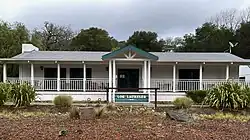Los Laureles Lodge
The Los Laureles Lodge is a historic American lodge in Carmel Valley, California. The Pacific Improvement Company used the lodge as a game preserve for Hotel Del Monte guests to hunt, fish, and canoe the Carmel River. It was once referred to as the Rancho Del Monte or Del Monte Dude Ranch. Today, the Los Laureles Lodge is a resort hotel and restaurant.[1]
| Los Laureles Lodge | |
|---|---|
| Rancho Del Monte Del Monte Dude Ranch | |
 | |
 | |
| Location | 313 W Carmel Valley Road, Carmel Valley, California |
| Coordinates | 36°33′59″N 121°56′48″W |
| Built | 1890s |
| Built for | Pacific Improvement Company |
| Original use | Lodge |
| Current use | Resort hotel |
| Website | loslaureles |
History
.jpg.webp)

The Los Laureles Lodge got its beginnings as part of Rancho Los Laureles, the 6,625-acre (26.81 km2) Mexican land grant in present-day Monterey County, California given in 1839 by Governor Juan Alvarado to José Manuel Boronda and Vicente Blas Martínez.[2] Rancho Los Laureles passed through several owners before being sold to Nathan Weston Spaulding (1829–1903) in 1874.[3][4] Spaulding owned the Los Rancho Laureles until 1881. He placed the rancho under the management of his brother-in-law, Kinzea Stone Clinkenbeard, who lived for a short time in the three-room Boronda Adobe until they built a more modern ranch house, which became known as the Los Laureles Lodge. Spaulding grew alfalfa on 1,000 acres (400 ha) of the ranch for cattle feed. Irrigation to water the fields and fencing were introduced for the first time in Carmel Valley.[5][4]
Pacific Improvement Company

In 1882, Spaulding sold Rancho Los Laureles to the Pacific Improvement Company (PIC). The Hotel Del Monte in Monterey, built in 1879, wanted the water rights from the Carmel River that ran through Rancho Los Laureles as well as a game preserve for their hotel guests.[3] In 1888, PIC hired William Hatton to manage their purchase and develop the Del Monte dairies and ranching operation in Los Laureles. In the 1890s, the Los Laureles ranch house became the "headquarters" for management of the lands the PIC had purchased.[5]: p198
In 1896, PIC added several guests cottages and enlarged the Los Laureles Lodge, to accommodate the Del Monte Hotel guests.[1]: p111 [6] Hatton modernized the diary operations, adding Durham cattle to the Holsteins.[1] Large vats and presses were installed to manufacture Monterey Jack cheese.[5]: p199 The Del Monte milk barn dates to 1890 when Hatton used the ventilation tower on the roof to cool the milk.[4]: p58 The Boronda adobe was the center for the PIC's dairy operation.[5]: p195
Del Monte Properties
In the 1900s the PIC liquidated their 10,000-acre (40 km2) holdings and the Del Monte Properties headed by Samuel FB Morse, acquired the land in 1919. In 1923, the Del Monte Properties divided the land into 11 parcels. Golf champion Marion Hollins bought 2,000 acres (800 ha), which later became the Camrel Valley Village and the Holman Ranch. Samuel Fertig from Pennsylvania, purchased Los Laureles that included the Boronda adobe and the Laureles Lodge.[5]: p201 [1]: p111
In the early 1930s, Muriel Vanderbilt Phelps bought the ranch from Fertig, converting the former Carriage House into a Ranch House and building stables.[5]: p202 [1]: p112 She built a swimming pool at the front of her ranch house. In May 1946, Vanderbilt sold 1,100 acres (450 ha) of the property to Frank B. Porter and his son Paul for an estimated $200,000 (equivalent to $3,001,365 in 2022), which included the Boronda Adobe. The property was converted into the Rancho Del Monte subdivision and Rancho Del Monte Country Club, which is now the Los Laureles Lodge.[7][8][9]
Present day
The Laureles Lodge is owned by Sanborn Griffin and is a resort hotel and restaurant.[5]: p202 The Del Monte milk barn was converted in 1940 to the White Oak Inn, later an art gallery, and a real estate office.[4]: p58
References
- Hale, Sharron Lee (1980). A Tribute to Yesterday: The History of Carmel, Carmel Valley, Big Sur, Point Lobos, Carmelite Monastery, and Los Burros. Santa Cruz, California: Valley Publishers. pp. 105–106. ISBN 9780913548738. Retrieved March 18, 2022.
- Hoffman, Ogden (1862). Reports of Land Cases Determined in the United States District Court for the Northern District of California. p. 73. Retrieved January 18, 2023.
{{cite book}}:|work=ignored (help)CS1 maint: location missing publisher (link) - Jackie Peterson (October 12, 1958). "This is Carmel Valley". The San Francisco Examiner. San Francisco, California. p. 190. Retrieved October 11, 2021.
- Barratt, Elizabeth (2009). Carmel Valley. pp. 8, 107. ISBN 9780738571621. Retrieved October 12, 2021.
{{cite book}}:|work=ignored (help) - Fink, Augusta (2000). Monterey County: The Dramatic Story of its Past. San Francisco: Western Tanager Press/Valley Publishers. pp. 196, 201–202. ISBN 9780913548622. Retrieved July 19, 2020.
- "Smart Set Of Oakland". Oakland Tribune. Oakland, California. February 17, 1907. p. 17. Retrieved February 7, 2023.
- "Carmel Valley". The Californian. Salinas, California. May 20, 1946. Retrieved December 29, 2022.
- Pat Griffith (February 4, 1970). "Mr. and Mrs. Frank Porter The Indomitable Family Who Developed Beautiful Carmel Valley". Carmel Valley Outlook. Carmel Valley, California. pp. 2–3. Retrieved December 30, 2022.
- "Peggy Porter Morrow Obituary". Legacy.com. March 7, 2014. Retrieved December 30, 2022.